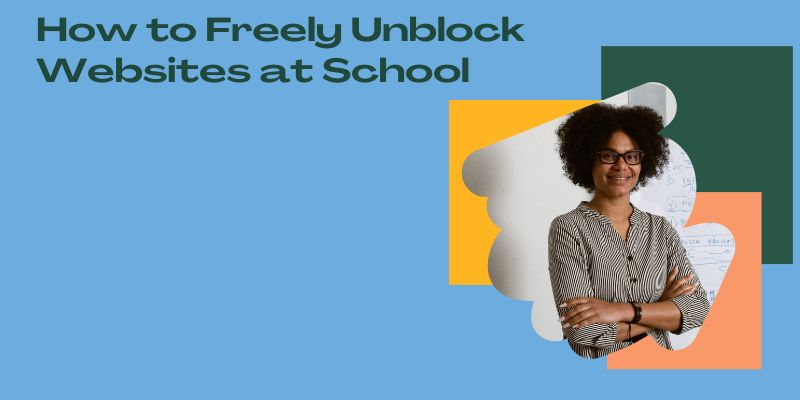How to Freely Unblock Websites at School
First off, how to unblock websites on the school Chromebook. A free VPN browser plugin is the most effective way to unblock websites at school. An alternative to that is a free web proxy, but it’s not nearly as reliable as a VPN browser add-on. Furthermore, both methods bypass restrictions on websites on Chromebooks used in schools.
And schools often don’t let students use the internet or visit certain websites. Some of these limitations are a mandatory part of the law, some are there to manage WiFi bandwidth, others are intended to boost student productivity, and a few additional measures to improve school network security.
How to unblock websites on school Chromebook
Today, more than 50 million students and teachers utilize Google Chromebooks in classrooms throughout the globe.
Their price, speed, and durability are the main reasons for their appeal, but they also make it simple for school administrators to implement content controls.
Installing website-unblocking apps, including VPN clients, on Chromebooks is considerably more difficult because not all of them enable local software installation.
Using a VPN plugin for Chrome, which enables you to swiftly and easily access prohibited websites on your ChromeOS device, is the easiest method for unblocking websites on a school Chromebook.
Ways to Get Websites Unblocked at School
Following extensive research, we have determined that the following five techniques are the most straightforward and successful ways to unblock websites at school:
1. Make Use of a VPN Extension
Setting up and using a VPN application is the most dependable, secure, and efficient method of unblocking websites at school. It is by far the most effective way to get around website bans.
The way a VPN operates is by constructing a tunnel through which your internet traffic passes. It accomplishes this by rerouting your connection through a distant VPN server (only the IP address of this server will be visible to the school’s local network).
The URL or IP address of the website you are seeing is the basis for the majority of school website restrictions. By concealing these characteristics behind the VPN connection, a VPN gets around school content restrictions.
The issue is that because administrators set up school machines to block the installation of unapproved software, using VPN software is nearly always impossible.
Thus, the next best course of action is to use a VPN browser plugin. Here are some easy steps for installing one on your browser.
2. Make Use of a Web Proxy
Using a web proxy is a fantastic way to unblock websites at school if you are unable to add a VPN plugin to your browser. They don’t require any setup, are free to use, and are rather dependable in getting over school limitations.
In essence, a web proxy is a website that has a proxy server integrated into it. The web proxy fetches the content of the restricted website for you in the same browser window when you only input its URL.
You can get past school blocks since the web proxy requests the IP address and URL of the website on your behalf. This indicates that the content filters at the school are not activated.
Text-based websites like Reddit love web proxies which are an amazing option for unblocking, and often are quite fast in terms of connecting. Streaming platforms rarely work but some gaming websites do.
Below is a small selection of web proxies we’ve found have worked with a bit of luck.
Unlike VPNs, web proxies are not encrypted. It helps the school and their ISP being able to monitor. Use caution while submitting content over a web proxy.
Nevertheless, they aren’t perfect — however, schools will limit access by adding the proxy’s URL to their network’s blocklist. If that is the case, we suggest giving a URL Unblocker tool a try.
URL Unblockers work much like a software web proxy that accesses the restricted website on your behalf from another computer to get around school restrictions. To do this they usually use a Chromium browser embedded version that you can manipulate from within the app itself.
As a rule, less secure, less private in fact, and far slower than a web proxy.
3. Make the move to mobile data
Unblocking websites at school may be done quickly and easily by using your phone’s data network instead of the school’s WiFi network.
Network-level implementations are used for the majority of school content filters. Your traffic travels across a firewall on the local network when you use the school’s WiFi. This firewall keeps an eye on the IP address, URL, and occasionally even the content of the website you’re on.
Your connection is prohibited if it finds a match between this and a blocklist.
By using your mobile data network instead of the school’s WiFi, you can get beyond these firewalls entirely.
School limitations no longer apply when you use mobile data to browse the internet. You can visit any websites that your mobile phone carrier permits.
This method allows you to utilize your phone as a personal hotspot to unblock websites on school Chromebooks and sometimes school PCs. This is because your computer’s traffic is sent via the network of your cell phone carrier rather than the network of your school.
It’s important to keep in mind that this approach will use up your phone’s data allotment, which may add up rapidly. If you are discovered using your phone in class, you can potentially face consequences.
In addition to these restrictions, there are two specific circumstances in which this approach will not be effective:
- Even when a student’s Chromebook is linked to a different local network, some schools set it up to constantly send traffic through the school’s servers. In this instance, the content restrictions set by your school are always applicable, irrespective of the network you are on.
- In addition to network-level firewalls, content-filtering software is sometimes deployed directly on school PCs and Chromebooks. This implies that website bans will remain in effect whether you are using the school’s WiFi or a mobile data network.
4. Make Use of a URL Shortener
A free internet application called a URL shortener takes a whole URL address and condenses it into a more manageable and shareable format. Users are then redirected to the original, lengthier URL after accessing the truncated version.
Although they can be used to unblock websites at school, URL shorteners are mostly employed to make URLs more user-friendly. This is because the application allows you to access restricted websites using a URL that the school’s content filters do not recognize.
Thus, it’s an excellent way to get around URL-based website restrictions, the most prevalent kind of school restriction. It functions equally well on personal devices, school laptops, and school Chromebooks, and it can be used for gaming and streaming.
Administrators at schools occasionally restrict access to the URL shortener website itself. You’ll need to locate one that isn’t blocked in this situation. Bitly, Ow.ly and TinyURL are well-known URL-shortening services.
When using a URL shortener at school, it’s crucial to remember that your network administrator can still see what you’re doing.
5. Make use of the Wayback Machine
Accessing a replica of the website instead of attempting to view the prohibited site itself is another method for unblocking websites at school. The Wayback Machine is the most effective method for doing this.
There are billions of copies of online pages in the Wayback Machine, a free digital archive. The way the program operates is by capturing screenshots of web pages and saving them in its database.
You can gain unrestricted access to the prohibited content by browsing an archived version of the website, which stops the school’s content filters from identifying the IP address or URL of the barred website.
Simple website bans at school may be quickly and easily circumvented by using the Wayback Machine, which doesn’t require any setup or manual installation.
Unless the URL has been added to the school network’s blacklist, it works on school computers and Chromebooks. It’s also probably the least likely technique to raise problems with your administrator or instructor.
However, it does have certain drawbacks. The website’s archived version might not always be the most recent. Furthermore, certain websites that are seen using the Wayback Machine might not be completely interactive or functioning.
This makes it the most effective way to unblock text-based websites. For certain websites, but not all of them, the program allows multimedia material (such as streaming music or video). Additionally, it won’t function for games.
Using the Wayback Machine: A Guide
The Wayback Machine can be used to unblock websites at school:
- Open your browser and navigate to web.archive.org.
- Enter the URL of the prohibited website into the search box on the webpage.
- Move your cursor over the calendar’s most current blue circle. If you would like, you may also examine previous iterations of the website.
- Select the latest timestamp by clicking on it. This will launch the most current version of the Wayback Machine-archived webpage.
Suggested Free Proxies for School Site Unblocking
Unblocking websites at school is sometimes accomplished by using a web proxy, however, the great majority of web proxies are dangerous to use.
They expose your traffic to hackers and, at best, leave it unencrypted. In the worst-case scenario, they will monitor your browser activities, sell this information to advertisers, insert advertisements as you surf, and occasionally even infect your device with malware.
As a result, only ever use a reliable and secure web proxy, such as the ones listed below.
1. Hide.me
The best private online proxy available for removing school limitations is Hide.me’s Proxy Browser. Because of its dedication to a no-logs policy, the service does not retain any logs of your online activities.
Additionally, the web proxy is more secure than kProxy. “Encrypt Page” is an option available to users in addition to “Encrypt URL.”
Regretfully, Hide.me doesn’t explain what these settings truly entail.
This is a positive start, even though it falls well short of the protection provided by a VPN or the Tor browser. It could also assist against more advanced school content filters from using keyword detection to restrict your connection.
Hide.me’s web proxy offers mediocre connection speeds in terms of performance. It provides three distinct server locations—the Netherlands, Germany, and Finland—and is roughly as dependable as kProxy at getting over school limitations.
All things considered, it’s a helpful tool for unblocking websites at school and provides more security and privacy than proxy.
2. kProxy
One well-known free web proxy is kProxy. However, it was unable to unblock websites as frequently or consistently as Hide.me in our tests.
When it did unblock websites, though, the load speeds were lightning quick and the proxy didn’t introduce any advertisements during the surfing session.
So, with a little trial and error, you can use kProxy to access websites that are restricted at school.
Ten distinct proxy servers are available for you to choose from in case of a mistake with kProxy. Although all of these are based in the US, which is advantageous for US students, non-US users may experience speed concerns.
Additionally, you should know that kProxy comes in both an unencrypted HTTP version and an encrypted HTTPS version. You should only ever use the encrypted version to ensure your safety and security.
The fact that kProxy always changes to the HTTP version when you transfer servers is one of its unpleasant features. Clicking the padlock icon to the left of the search bar will return you to the HTTPS version.
Conclusion
Finally, while setting the internet restrictions on school Chromebooks might be hard to navigate, learning about all these ways of unblocking sites can give students the power to utilize useful internet resources for learning or research. Through browsing extensions, network settings adjustment, or even relying on the staff of IT, for instance, users can improve their online experience. But you should understand school policies and use these tools appropriately.
While you’re looking into these options, think about tapping your peers and educators to create a collaborative space where internet freedom has value in education and where access and responsibility are concepts that should be embraced. Advocating for a balanced approach to internet usage within your school and capitalizing on your learning will be that initiative.
also read our recent articles:-
Top Affiliate Marketing Resources to Boost Revenue and Bring in Quality Traffic










